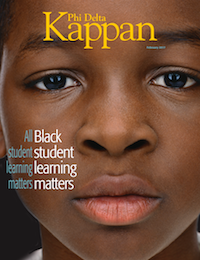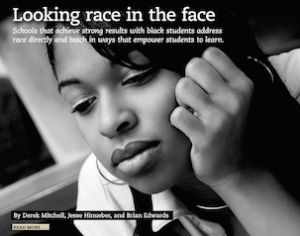 The February issue of the excellent Kappan magazine arrived recently. Its theme is “Black Student Learning Matters.” and the magazine is a treasure trove of resources and ideas to help educators ensure every student is engaged and successful, particularly those of color.
The February issue of the excellent Kappan magazine arrived recently. Its theme is “Black Student Learning Matters.” and the magazine is a treasure trove of resources and ideas to help educators ensure every student is engaged and successful, particularly those of color.
 One article that particularly struck me was written by members of the Partners in School Innovation, based in San Francisco. Entitled “Looking Race in the Face,” the article surfaces four efforts that educators can make to help ensure success with black students:
One article that particularly struck me was written by members of the Partners in School Innovation, based in San Francisco. Entitled “Looking Race in the Face,” the article surfaces four efforts that educators can make to help ensure success with black students:
- They direct attention, strategies, and resources to black student achievement.
- They provide opportunities for adult learning about race, culture, class, and power and about how those dynamics make certain communities vulnerable.
- They foster strong relationships between educators and black students.
- They create classroom environments that emphasize excellence and empower students to exercise agency over their own learning. (p. 24)
In other words, building trusting relationships, being culturally in tune, holding high expectations, and providing needed supports are critical.
The authors further suggest that a safe and collaborative culture in schools matters. Specifically, they identify four types of student mindset that should be valued and visible in a school’s culture:
 Belonging: “I belong in this academic community.”
Belonging: “I belong in this academic community.”- Value: “The work has value to me.”
- Growth Mindset: With effort, my skills can grow.”
- Self-Efficacy: “I can do this.” (p. 28)
“Looking Race in the Face” is publicly available at the Kappan website
As you read the ideas of Derek Mitchell, Jesse Hinueber and Brian Edwards, I hope you’ll find them extending your thinking and understanding about successfully engaging all students. And please share your own wisdom, along with additional ideas and strategies that you have found to be successful, at the end of this post.
“Learning from Our Elders”
Long-time national teacher leader Renee Moore has another insightful article in this same issue of the Kappan, titled “Learning from Our Elders.”
 Among Renee Moore’s many accomplishments: Mississippi Teacher of the Year; a member of the Board of Directors of the National Board of Professional Teaching Standards (NBPTS); a member of the Board of Directors of the Carnegie Foundation for the Advancement of Teaching; a Milken Award winner; and a member of the Center for Teaching Quality Advisory Board and the Bread Loaf Teacher Network Advisory Board. After a long career in K-12, Renee is now a Teacher of English at Mississippi Delta Community College.
Among Renee Moore’s many accomplishments: Mississippi Teacher of the Year; a member of the Board of Directors of the National Board of Professional Teaching Standards (NBPTS); a member of the Board of Directors of the Carnegie Foundation for the Advancement of Teaching; a Milken Award winner; and a member of the Center for Teaching Quality Advisory Board and the Bread Loaf Teacher Network Advisory Board. After a long career in K-12, Renee is now a Teacher of English at Mississippi Delta Community College.
Her Kappan article is not free to the public, but it’s a must-read for anyone trying to gain more perspective on the importance of a racially and culturally diverse teacher corps and the impact black teachers can have on both black and white students. It’s well worth the $5 fee to access and download.
Here’s the abstract of her Kappan piece:
Teachers in rural, black schools understood their communities and their students and provided lessons that are still relevant today. The three main lessons are to learn and use culturally appropriate teaching, initiate and maintain mutually respectful community connections, and expect great things from every student.
And a few excerpts:

“The wisdom and teaching traditions honed by black educators who worked mostly in southern rural schools continue to be marginalized — and even denigrated — by the broader educational community,” Moore writes. “But we can draw at least three lessons from those traditions, including instructional techniques, community partnerships, and teacher expectations, that rural and urban American schools could adopt today to support black student learning.”
In her own classroom, Moore practices what she calls culturally engaged pedagogy, which has roots in choral recitations, call-and-response, and oral instruction. “I still use techniques I learned from my black teachers and mentors.” For example:
- “I routinely give composition students both written and oral assessments. Student writing portfolios are presented, not just submitted. “
- “Blended learning approaches allow for relatively easy mixing of teaching and learning styles, such as using audio-video for instruction and assessment performances, along with live and asynchronous group conversations or collaborations.”
“The highest praise I ever got for my teaching was from a particularly jaded group of black sophomores who proclaimed, ‘We like the way you break things down.’ Listening to and learning from other black teachers, and most of all to students and their parents, has helped me see broader possibilities for students’ learning when I purposefully combine approaches that are culturally appropriate.”
Access Renee Moore’s complete article here
When National Public Radio asked five outstanding American teachers about the qualities that make a great teacher, this was Renee Moore’s answer:
The Hebrew word for teach has, among its meanings: to aim or shoot like an arrow, to point like a finger, to flow like water. The word reminds me of what parents do when we teach our child to ride a bike. The first time, we may ride with her or turn the pedals. Next time, we steer while she pedals. Finally, the moment comes when we balance her, aim her down the sidewalk, push her off and let go.
Great teachers do that: They start or move the minds of their students along a path, prepare them for the journey and propel them into the future. And they do it consistently and passionately.
Please share your thoughts!

0 Comments on "Ideas from the KAPPAN: Successfully Engaging Black Students"